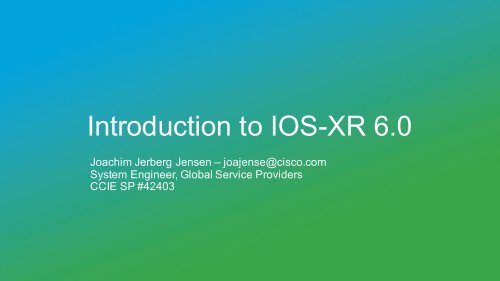Introduction to IOS-XR 6.0
3EMRB
3EMRB
Create successful ePaper yourself
Turn your PDF publications into a flip-book with our unique Google optimized e-Paper software.
<strong>Introduction</strong> <strong>to</strong> <strong>IOS</strong>-<strong>XR</strong> <strong>6.0</strong><br />
Joachim Jerberg Jensen – joajense@cisco.com<br />
System Engineer, Global Service Providers<br />
CCIE SP #42403
Agenda<br />
• <strong>Introduction</strong><br />
• Software Architecture Overview<br />
• Flexible Packaging<br />
• Application Hosting<br />
• Configuration, Moni<strong>to</strong>ring and Troubleshooting<br />
• Conclusions<br />
Presentation ID<br />
© 2016 Cisco and/or its affiliates. All rights reserved. Cisco Public<br />
2
<strong>Introduction</strong><br />
Presentation ID<br />
© 2016 Cisco and/or its affiliates. All rights reserved. Cisco Public<br />
3
… coming <strong>to</strong> a platform closer <strong>to</strong> you<br />
In development<br />
Not committed yet<br />
NCS5001<br />
NCS5011<br />
NCS1002 w/ macsec<br />
NCS5002<br />
NCS5502<br />
NCS5508<br />
NCS1002<br />
NCS5501<br />
ASR9000(*)<br />
NCS 6000<br />
Q4 CY15 Q2 CY16 Q4 CY16<br />
* On ASR9k, 32-bit QNX images and 64-bit linux images will be supported<br />
Presentation ID<br />
© 2016 Cisco and/or its affiliates. All rights reserved. Cisco Public<br />
4
Guiding Principles for <strong>IOS</strong>-<strong>XR</strong> operational enhancements<br />
Bring Your own Application<br />
• Provide a platform on which cus<strong>to</strong>mers can host their apps (3 rd party apps,<br />
cus<strong>to</strong>mer apps, cisco apps)<br />
Au<strong>to</strong>matable interfaces<br />
• Provide visibility in<strong>to</strong> the device through machine friendly interfaces<br />
Open architecture à Decrease <strong>to</strong>ol chain variance<br />
• Fit in<strong>to</strong> cus<strong>to</strong>mer’s operational workflow<br />
© 2015 Cisco and/or its affiliates. All rights reserved.<br />
Cisco Confidential 5
Pillars of <strong>IOS</strong>-<strong>XR</strong> operational enhancements<br />
Visibility &<br />
Telemetry<br />
• Operational Data, Deep analytical hooks<br />
• Policy-based, flexible, Push Model<br />
Evolved<br />
Programmability<br />
• Data accessible via published model driven interfaces<br />
• Machine friendly<br />
• Enables au<strong>to</strong>mation @ scale<br />
Application<br />
Hosting<br />
• Ability <strong>to</strong> run 3 rd party off the shelf applications built with Linux <strong>to</strong>ol chains<br />
• Run cus<strong>to</strong>m applications inside an LXC container on the 64-bit Linux host<br />
Flexible Platform<br />
and Packaging<br />
• Packages can be inspected on box using standard <strong>to</strong>ol chain (RPM <strong>to</strong>ols)<br />
• Au<strong>to</strong>mated package dependency checkers<br />
• Open Bootloaders (iPXE) and end-<strong>to</strong>-end au<strong>to</strong>-provision<br />
Presentation ID<br />
© 2016 Cisco and/or its affiliates. All rights reserved. Cisco Public
Software Architecture<br />
Presentation ID<br />
© 2016 Cisco and/or its affiliates. All rights reserved. Cisco Public<br />
7
<strong>IOS</strong> <strong>XR</strong> <strong>6.0</strong> introduces a new software infrastructure offering<br />
• 64-bit OpenEmbedded Linux support.<br />
Ø Processes containerization.<br />
Ø Brings in standard Linux <strong>to</strong>olchain.<br />
Ø Third-Party Applications Support.<br />
Classic <strong>XR</strong> <strong>XR</strong> <strong>6.0</strong><br />
• NCS 5500, NCS 5000 and NCS1002<br />
will support only 64-bit Linux<br />
System<br />
Control<br />
System<br />
Admin<br />
Control<br />
Admin<br />
• ASR 9000 will still have 32-bit QNX<br />
support<br />
32 bit QNX<br />
NPU<br />
64 bit Linux<br />
X86 Hardware<br />
8
<strong>Introduction</strong> <strong>to</strong> Containers<br />
Traditional Virtualization<br />
App App<br />
• LXC (LinuX Containers) let you run a<br />
Linux system within another Linux system.<br />
Lib<br />
OS<br />
Lib<br />
OS<br />
• A container is a group of processes on a<br />
Linux machine.<br />
• Those processes form an isolated<br />
Operating System<br />
Hypervisor<br />
X86 Hardware<br />
environment.<br />
Containers<br />
• Inside the container, it looks like a Virtual App App<br />
Machine.<br />
Lib Lib<br />
• Outside the container, it looks like normal<br />
…<br />
processes running on the system.<br />
OS OS<br />
• Containers look like Virtual Machines, but<br />
are more efficient.<br />
Operating System<br />
X86 Hardware<br />
9<br />
…
Why Containers?<br />
• They are Fast Deploy and Boot in less than one Second vs Minutes for<br />
Virtual Machines<br />
• They are Lightweight Only a few MB of Disk Space per Container vs<br />
several hundred MB for traditional Virtual Machines.<br />
• They provide Similar Services as VMs Each container has:<br />
• Its own network interfaces<br />
LXC1 LXC2<br />
- Can be bridged, routed... just like with KVM.<br />
App App<br />
• Its own filesystem<br />
- e.g.: RedHat host can run Debian container.<br />
• Isolation (security)<br />
- Two containers can't harm (or even see) each other.<br />
• Isolation (resource usage)<br />
- Soft & Hard quotas for RAM, CPU, I/O.<br />
Lib<br />
OS<br />
Lib<br />
OS<br />
Operating System<br />
X86 Hardware<br />
…<br />
10
Linux Containers – Kernel Requirements<br />
• To create a virtual environment, containers use the following kernel features.<br />
App<br />
Lib<br />
OS<br />
App<br />
Lib<br />
…<br />
OS<br />
Operating System<br />
X86 Hardware<br />
1. Namespaces: Partition essential kernel<br />
structures <strong>to</strong> create virtual environments:<br />
• pid (processes)<br />
• net (network interfaces, routing...)<br />
2. Control Groups: Limit, account, and isolate<br />
resource usage:<br />
• Exposed through a virtual filesystem<br />
3. Chroot: operation that changes the apparent<br />
root direc<strong>to</strong>ry of the container process.<br />
11
<strong>IOS</strong>-<strong>XR</strong> Container Architecture<br />
Modular Router<br />
Fixed Router<br />
LXC LXC LXC<br />
Control<br />
Plane<br />
Admin <br />
Plane<br />
Third<br />
Party<br />
Control<br />
Plane<br />
Admin <br />
Plane<br />
Third<br />
Party<br />
64-‐bit Host OS<br />
64-‐bit Host OS<br />
Routing Processor<br />
Routing Processor<br />
Fabric<br />
Line Card <br />
64-‐bit Host OS<br />
Control<br />
Plane<br />
Admin <br />
Plane<br />
LXC LXC<br />
Fabric<br />
Front Panel<br />
12
<strong>IOS</strong>-<strong>XR</strong> Container Roles: The Host<br />
Control<br />
Plane<br />
Admin <br />
Plane<br />
64-‐bit Host OS<br />
Routing Processor<br />
Third<br />
Party<br />
• Runs Yoc<strong>to</strong> based 64-bit Open<br />
Embedded Linux kernel.<br />
• Built using Windriver 7<br />
• The main functions of the host are:<br />
• Interact directly with the underlying<br />
hardware.<br />
• Provide kernel services for the<br />
containers.<br />
• Provide libraries, <strong>to</strong>ols, and utilities <strong>to</strong><br />
help launch, moni<strong>to</strong>r, and maintain<br />
containers.<br />
• Provide the network infrastructure <strong>to</strong><br />
allow containers <strong>to</strong> communicate.<br />
13
<strong>IOS</strong>-<strong>XR</strong> Container Roles: The Control Plane<br />
Control<br />
Plane<br />
Admin <br />
Plane<br />
64-‐bit Host OS<br />
Routing Processor<br />
Third<br />
Party<br />
• The heart of <strong>IOS</strong>-<strong>XR</strong> <strong>6.0</strong><br />
• Runs a Yoc<strong>to</strong> based 64-bit OELinux<br />
composed of 2 types of packages:<br />
1. Cisco developed packages for core<br />
network functions (BGP, MPLS, etc.)<br />
2. Yoc<strong>to</strong> packages for standard Linux<br />
<strong>to</strong>ols and libraries (bash, python,<br />
tcpdump, etc.).<br />
14
<strong>IOS</strong>-<strong>XR</strong> Container Roles: The Admin Plane<br />
Control<br />
Plane<br />
Admin <br />
Plane<br />
64-‐bit Host OS<br />
Routing Processor<br />
Third<br />
Party<br />
• Runs a Yoc<strong>to</strong> based 64-bit Linux.<br />
• Provides services that were originally<br />
provided by the admin mode of <strong>XR</strong>.<br />
• Runs processes responsible <strong>to</strong><br />
perform system diagnostics, moni<strong>to</strong>r<br />
environmental variables, and manage<br />
hardware components.<br />
• First container <strong>to</strong> be booted by the<br />
host, and is responsible for the start<br />
and maintenance of all the other<br />
containers in the system.<br />
15
<strong>IOS</strong>-<strong>XR</strong> Container Roles: Third Party<br />
• Runs any 64-bit Linux distribution.<br />
• Launched from the <strong>XR</strong> container<br />
using virsh and libvirtd.<br />
Control<br />
Plane<br />
Admin <br />
Plane<br />
Third<br />
Party<br />
• Access Network Interface through the<br />
Third Party Network Name Space<br />
(TPNNS).<br />
64-‐bit Host OS<br />
Routing Processor<br />
16
<strong>XR</strong> Boot Process<br />
• <strong>XR</strong> <strong>6.0</strong> image will be released in the form of bootable self-extracting ISOs<br />
• Similar <strong>to</strong> any Linux distribution.<br />
• NCS 5000 and 5500 possess a B<strong>IOS</strong> that offers NetBooting using iPXE.<br />
• iPXE is an open-source network boot firmware that supports:<br />
1. Booting from HTTP/HTTPS.<br />
2. Controlling the boot process via scripts.<br />
3. Performing image validation.<br />
• <strong>XR</strong> <strong>6.0</strong> comes with an Au<strong>to</strong>-Provision process<br />
• Executed at the end of the control-plane boot sequence.<br />
• Executed inside the Shell.<br />
• Can execute Scripts or apply Static Configuration.<br />
17
18<br />
<strong>IOS</strong>-<strong>XR</strong> Boot Process with iPXE<br />
N<br />
iPXE<br />
boot<br />
Y<br />
iPXE<br />
<strong>XR</strong> Install<br />
2<br />
1<br />
DHCP SERVER<br />
IP address<br />
Next-server<br />
Filename=http:///image-new.ISO<br />
IP address<br />
Next-server<br />
Filename=http:///Au<strong>to</strong>Prov-SN.sh<br />
or<br />
Filename=http:///Config-SN.txt<br />
HTTP SERVER<br />
<strong>XR</strong> Boot<br />
3<br />
Image-new.ISO<br />
Au<strong>to</strong>Provision<br />
execution<br />
4 GET script-SN.sh or config-SN.txt<br />
script-SN.sh<br />
config-SN.txt<br />
Apply<br />
Configuration<br />
Execute script<br />
5<br />
GET addon scripts/packages/configuration<br />
Presentation ID<br />
Additional<br />
Scripts<br />
Packages, etc…<br />
© 2016 Cisco and/or its affiliates. All rights reserved. Cisco Public
Single DHCP Server Configuration<br />
host NCS5500-rp0 {<br />
}<br />
hardware ethernet e4:c7:22:be:10:ba;;<br />
fixed-address 192.168.0.10;;<br />
If exists user-class and option user-class = "iPXE" {<br />
# Image request, provide ISO<br />
filename "http://192.168.0.10/images/ncs5500 -mini-x.iso-r<strong>6.0</strong>.0 ";;<br />
} elsif exists user-class and option user-class = "exr-config" {<br />
}<br />
# Au<strong>to</strong>-provision request, provide script or configuration<br />
filename "http://192.168.0.10/scripts/ncs5500-rp0.sh";;<br />
Presentation ID<br />
DHCP<br />
option 77<br />
DHCP<br />
option 67<br />
© 2016 Cisco and/or its affiliates. All rights reserved. Cisco Public<br />
19
NCS 5000 on board ports<br />
• Management Ethernet 0 and 1 is mapped <strong>to</strong> <strong>IOS</strong>-<strong>XR</strong><br />
Permanently<br />
• Console port uses Console mux feature (By using CTRL+O<br />
we can switch between the HOST OS(Linux), Admin LXC<br />
and <strong>XR</strong> LXC<br />
Presentation ID<br />
© 2016 Cisco and/or its affiliates. All rights reserved. Cisco Public
NCK5K B<strong>IOS</strong><br />
• NCS5K B<strong>IOS</strong> can be accessed by either pressing “esc” or “F12” Key when Box is<br />
Powered.<br />
• It will list out following options<br />
(1) UEFI: SMART eUSB HS-SD/MMC (Internal Disk)<br />
(2) UEFI: Sony S<strong>to</strong>rage Media 0100 (External USB )<br />
(3) UEFI: Built-in EFI IPXE<br />
(4) UEFI: Built-in EFI Shell<br />
• Boot order can be Changed on the B<strong>IOS</strong> Menu<br />
Presentation ID<br />
© 2016 Cisco and/or its affiliates. All rights reserved. Cisco Public
Boot With External USB<br />
• Download the uncompressed image file in external USB.<br />
• It contains folder structure with following files<br />
EFI/Cisco/ncs5k-mini-x.iso<br />
\EFI\Cisco\grub.efi<br />
\EFI\Cisco\bootx64.efi<br />
\EFI\Cisco\grub.cfg<br />
Presentation ID<br />
© 2016 Cisco and/or its affiliates. All rights reserved. Cisco Public
What will you see<br />
iPXE in action<br />
iPXE 1.0.0+ (3e573) -- Open Source Network Boot Firmware --<br />
http://ipxe.org<br />
Features: DNS HTTP TFTP VLAN EFI ISO9660 NBI Menu<br />
Trying net0...<br />
net0: c4:72:95:a6:14:e1 using dh8900cc on PCI01:00.1 (open)<br />
[Link:up, TX:0 TXE:0 RX:0 RXE:0]<br />
Configuring (net0 c4:72:95:a6:14:e1).................. Ok
Flexible Packaging<br />
Presentation ID<br />
© 2016 Cisco and/or its affiliates. All rights reserved. Cisco Public<br />
24
Networking Software Delivery Direction<br />
What<br />
• Server-like Workflows<br />
• Modular, Disaggregated<br />
• Integration with Stack<br />
• Reduced Delivery Cycles<br />
How<br />
• Linux Operations<br />
• Business Driven Packaging<br />
• Programmatic Validation<br />
• Targeted Validation<br />
Presentation ID<br />
© 2016 Cisco and/or its affiliates. All rights reserved. Cisco Public
RPM: <strong>XR</strong> New Package Format<br />
• RPM Package Manager is the new Package format starting with <strong>IOS</strong>-<strong>XR</strong> <strong>6.0</strong>.<br />
• Packages are placed in a reachable reposi<strong>to</strong>ry and accessed via<br />
FTP/SFTP/SCP/TFTP or HTTP or pre-staged on the box<br />
• Third Party packages are installed with RPM or YUM inside the Shell.<br />
• <strong>IOS</strong>-<strong>XR</strong> packages are installed with “install update/upgrade”.<br />
• Install commands are a wrapper around YUM <strong>to</strong> provide multi-arch support.<br />
• Both YUM and install commands provide dependency verification/resolution.<br />
26
Ana<strong>to</strong>my of RPM Packages<br />
RPM<br />
Archive<br />
MetaData<br />
CPIO binary Archive<br />
Describe package contents<br />
Install structure<br />
Dependencies<br />
/var/lib/rpm<br />
Scriptlet<br />
Pre and Post Install Instructions<br />
Database of installed packages<br />
Presentation ID<br />
© 2016 Cisco and/or its affiliates. All rights reserved. Cisco Public<br />
27
<strong>XR</strong> Packages Naming Convention<br />
Package<br />
--..rpm<br />
ncs5500-mpls-1.0.0.0-r600.x86_64.rpm<br />
SMU<br />
--...rpm<br />
ncs5500-mpls-1.0.0.1-r600.CSCab12345.x86_64.rpm<br />
Presentation ID<br />
© 2016 Cisco and/or its affiliates. All rights reserved. Cisco Public<br />
28
Package Reposi<strong>to</strong>ry<br />
www.cisco.com<br />
Local Reposi<strong>to</strong>ry<br />
Platform<br />
Release<br />
<strong>XR</strong> Software<br />
<strong>XR</strong> SMUs<br />
Svc Pak<br />
Mini ISO<br />
+<br />
Pkgs<br />
Mini ISO<br />
+<br />
k9 pkg<br />
+<br />
Pkgs<br />
Full K9 ISO<br />
Full ISO<br />
DDTS SMU<br />
DDTS SMUs<br />
<br />
<strong>6.0</strong>.0.17L<br />
ncs-5500-mini-x.iso-<strong>6.0</strong>.0.17L.iso<br />
ncs-5500-mpls-te-rsvp-1.1.0.0-r60017L.x86_64.rpm<br />
ncs-5500-bgp-1.0.0.0-r60017L.x86_64.rpm<br />
ncs-5500-eigrp-1.0.0.0-r60017L.x86_64.rpm<br />
ncs-5500-k9sec-1.0.0.0-r60017L.x86_64.rpm<br />
ncs-5500-mgbl-2.0.0.0-r60017L.x86_64.rpm<br />
ncs-5500-mpls-1.1.0.0-r60017L.x86_64.rpm<br />
ncs-5500-m2m-1.0.0.0-r60017L.x86_64.rpm<br />
ncs-5500-mpls-1.1.0.1-r60017L.CSCab12345.x86_64.rpm<br />
Presentation ID<br />
© 2016 Cisco and/or its affiliates. All rights reserved. Cisco Public<br />
29
Updating <strong>XR</strong> Packages<br />
Command Line<br />
install update source <br />
install update source ncs5500-mpls<br />
install update source ncs5500-mpls-<br />
1.0.0.1-r622.CSCab12345.x86_64.rpm<br />
install update source ncs5500-mpls-<br />
1.0.2.0-r622.x86_64.rpm<br />
Behavior<br />
No package specified, update latest SMUs of all<br />
installed packages<br />
Package name specified, will install that package,<br />
update all latest SMUs of that package(s) (along with<br />
its dependencies).<br />
SMU installation: the SMU will be downloaded and<br />
installed (along with its dependent SMUs).<br />
Asynchronous package upgrade, that package will be<br />
installed (along with its dependent SMUs).<br />
Available in future release<br />
30
Upgrading <strong>XR</strong> Packages<br />
Command Line<br />
Behavior<br />
install upgrade source version 6.1.1 Upgrade the base image <strong>to</strong> the specified version.<br />
All installed packages will be upgraded <strong>to</strong> same<br />
release as the base package.<br />
install upgrade source version 6.1.1<br />
ncs5500-mpls-1.0.2.0-r623.x86_64.rpm<br />
Perform install upgrade and install update for a<br />
specific package(s) in one operation.<br />
31
PIE Install<br />
RPM Install<br />
• No dependency management<br />
• Offline process required <strong>to</strong> copy packages<br />
• Require multiple operations<br />
• install add<br />
• install activate<br />
• install commit<br />
• CSM for package content<br />
• Dependency management<br />
• Online process over secure transport<br />
• Single operation<br />
• install update or install upgrade<br />
• On-box / Off-box package inspection<br />
using rpm <strong>to</strong>ol<br />
• Description<br />
• Dependencies<br />
• Content<br />
Presentation ID<br />
© 2016 Cisco and/or its affiliates. All rights reserved. Cisco Public<br />
32
Installing and Updating Third Party Packages<br />
• Third Party Packages are traditional Linux <strong>to</strong>ols available from the Shell<br />
• Communication: lighttpd ,openssh, wget, curl, etc.<br />
• Programing: python, ruby, perl, etc.<br />
• Utilities: sed, gawk, tar, gzip, vi, etc.<br />
• Additional packages provided by vendors (No Cisco Support)<br />
• Chef<br />
• Puppet<br />
• Installed using yum or rpm<br />
yum-config-manager --add-repo=http://192.168.0.254/<strong>XR</strong>/<strong>6.0</strong>.0<br />
yum install chef –y<br />
33
Application Hosting<br />
Presentation ID<br />
© 2016 Cisco and/or its affiliates. All rights reserved. Cisco Public<br />
34
Third Party Network Name Space<br />
• Provide visibility of fabric<br />
attached interfaces outside<br />
of <strong>XR</strong> CLI.<br />
• Available <strong>to</strong> processes in the<br />
<strong>XR</strong> containers or Third Party<br />
containers.<br />
• Requires that the interface is<br />
Up with a valid IP address.<br />
• Routing handled by <strong>XR</strong>.<br />
Control Plane Admin Plane Third Party<br />
TPNNS<br />
TPNNS<br />
Internal<br />
IPC<br />
Interfaces<br />
Mgmt<br />
Gig<br />
TenGig<br />
HunGig<br />
64-bit Host OS<br />
TPNNS<br />
Routing Processor<br />
Mgmt<br />
Gig<br />
TenGig<br />
HunGig<br />
[xr-vm_node0_RP0_CPU0:~]$ip netns exec tpnns bash<br />
35
Third Party Container Application Workflow<br />
• Create the Container archive on a Linux<br />
Server.<br />
• Copy the archive file <strong>to</strong> /misc/app_host.<br />
• Unarchive in a rootfs direc<strong>to</strong>ry.<br />
• Create XML file specifying LXC<br />
parameters.<br />
• Run virsh command.<br />
1<br />
Create<br />
2 Deploy<br />
3 Launch<br />
Control<br />
Plane<br />
Admin <br />
Plane<br />
64-‐bit Host OS<br />
Routing Processor<br />
Third<br />
Party<br />
virsh –c lxc+tcp://10.11.12.15:16509 create <br />
36
Configuration, Moni<strong>to</strong>ring<br />
and Troubleshooting<br />
Presentation ID<br />
© 2016 Cisco and/or its affiliates. All rights reserved. Cisco Public<br />
37
Streaming Telemetry: <strong>Introduction</strong><br />
Where Data Is Created<br />
Where Data Is Useful<br />
SNMP<br />
sensing &<br />
measurement<br />
syslog<br />
CLI<br />
s<strong>to</strong>rage &<br />
analysis<br />
Presentation ID<br />
© 2016 Cisco and/or its affiliates. All rights reserved. Cisco Public<br />
38
Streaming Telemetry<br />
Design Vision<br />
Performance<br />
• Get as much data off the box as quickly<br />
as possible<br />
Coverage<br />
• Grant full access <strong>to</strong> all operational data<br />
on the box<br />
Au<strong>to</strong>mation<br />
• Serialize the data in a flexible, efficient<br />
way that fits cus<strong>to</strong>mers au<strong>to</strong>mated <strong>to</strong>ols<br />
39
Telemetry<br />
• Common modeling language: Goal is YANG (experimental SysDB name space in <strong>6.0</strong>)<br />
• Describes moni<strong>to</strong>ring data structure and attributes<br />
• Push Model<br />
• Stream data continuously with incremental updates based on subscriptions<br />
• Data delivery:<br />
• JSON (compressed) inside TCP.<br />
• Google Pro<strong>to</strong>col Buffer inside UDP.<br />
• Google Pro<strong>to</strong>col Buffer inside gRPC.<br />
• Observe network state through a time-series data stream<br />
40
Streaming Telemetry Model<br />
• Telemetry Configuration<br />
• Described in JSON.<br />
• Define one or multiple collection<br />
group(s).<br />
• Each group contains a rate and a pointer<br />
<strong>to</strong> one or multiple objects in the<br />
experimental SysDB path (<strong>6.0</strong> only)<br />
• Telemetry Policy<br />
• Define the encoder, transport and the<br />
receiver(s) for each policy.<br />
• Telemetry Agent<br />
• <strong>XR</strong> process that runs au<strong>to</strong>matically and<br />
looks for registered policies <strong>to</strong> act on.<br />
Telemetry<br />
Receiver<br />
Presentation ID<br />
<strong>XR</strong> Control Plane<br />
Telemetry<br />
Configuration Namespace<br />
Telemetry<br />
Agent<br />
Host OS<br />
Telemetry<br />
Policy<br />
© 2016 Cisco and/or its affiliates. All rights reserved. Cisco Public<br />
41
Streaming Telemetry Example<br />
{<br />
"Name": "GenericCounters",<br />
"Metadata": {<br />
"Version": 25,<br />
"Description": "This is a sample policy <strong>to</strong> demonstrate the syntax",<br />
"Comment": "This is the first draft",<br />
"Identifier": ""<br />
},<br />
"CollectionGroups": {<br />
"FirstGroup":{<br />
"Period": 30,<br />
"Paths":["RootOper.InfraStatistics.Interface([*]).Latest.GenericCounters"]<br />
}<br />
}<br />
}<br />
Presentation ID<br />
© 2016 Cisco and/or its affiliates. All rights reserved. Cisco Public<br />
42
Network Configuration Pro<strong>to</strong>col (NETCONF)<br />
• NETCONF provides mechanisms <strong>to</strong> install, manipulate, and delete device<br />
configuration.<br />
• It uses an XML based data encoding for the configuration data as well as the<br />
pro<strong>to</strong>col messages.<br />
• NETCONF pro<strong>to</strong>col operations are realized as remote procedure calls (RPCs)<br />
over SSH.<br />
SSH Clients<br />
SSH<br />
Retrieve, Configure, Copy, and Delete<br />
Networking Device<br />
RPC calls are divided in 4 groups of methods: Retrieve, Configure, Copy, and Delete.<br />
Additional methods can be supported<br />
43
Programmatic Interface<br />
Secure<br />
Transport<br />
Connection<br />
Oriented<br />
Negotiate<br />
Capabilities<br />
RPC-based<br />
communication<br />
model<br />
Configuration<br />
Manager<br />
Backend<br />
Apps<br />
SSHd<br />
<strong>XR</strong><br />
Programmatic<br />
Interface<br />
SSH<br />
Proxy<br />
Server<br />
NETCONF<br />
Agent<br />
YANG<br />
Framework<br />
SysDB<br />
Client<br />
Library<br />
SysDB<br />
Web<br />
Server<br />
RESTCONF<br />
Agent<br />
<strong>XR</strong> YANG<br />
Presentation ID<br />
© 2016 Cisco and/or its affiliates. All rights reserved. Cisco Public<br />
44
Conclusions<br />
Presentation ID<br />
© 2016 Cisco and/or its affiliates. All rights reserved. Cisco Public<br />
45
Key Takeaway<br />
• No Change in traditional CLI Operation<br />
• In <strong>6.0</strong>, available on NCS-5500, NCS-5000 and NCS1000 Platform<br />
• In 6.1.1, available on ASR9k (traditional 32-bit QNX offering will still be<br />
supported)<br />
• Operational enhancement for Au<strong>to</strong>mated Operations<br />
• Operating System change for Open Source <strong>to</strong>oling<br />
46
<strong>IOS</strong> <strong>XR</strong> <strong>6.0</strong> Operational Enhancements<br />
<strong>IOS</strong> <strong>XR</strong> <strong>6.0</strong><br />
Visibility & Telemetry<br />
Evolved programmability<br />
Application Hosting<br />
Flexible Platform & Packaging<br />
Presentation ID<br />
© 2016 Cisco and/or its affiliates. All rights reserved. Cisco Public<br />
47
We’re ready. Are you?









